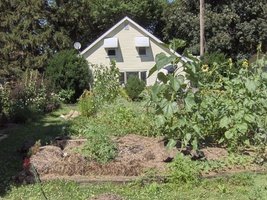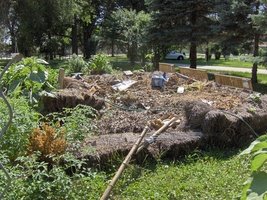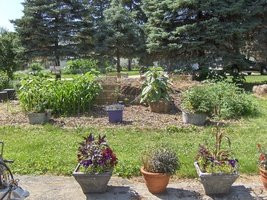





My main compost pile begins each fall with a "corral" of straw bales. It is 2 bales high & about 3 by 5 bales on the sides, depending on the area I'm using. I fill this all year long with anything that will rot, whether it be animal, vegetable or mineral. When the bales start to collapse along with the compostables, I top it off with thick pads of straw & let it sit over the winter. By spring, it has shrunk to about 18 inches high, and I use it as a planting platform for such crops as tomatoes & cantaloupe, which co-exist happily & benefit from not being exposed to soil splash. (You can read all about that in my first article about composting.)
Well, now that I've been in my new place for 3 summers, my first corral was ready to harvest this spring. Except that, once I sank a shovel into it, I discovered that it was still a pretty coarse pile, which is understandable given that I threw everything from branches to to magazines into it, then paid no attention to such factors as temperature, moisture or green-vs.-brown proportions, much less expending the labor to turn the ingredients. So, on the "hot" and "cold" composting spectrum, this particular pile was Ice Nine. It was definitely compost, but not the fine seedbed texture that I've grown accustomed to here on Illinois' old riverbeds.
Plus, the only gardening chore that I cannot force myself to do, in fact have NEVER done, is shovel soil. Faced with a 10-by-20-foot pile of coarse compost, it suddenly occurred to me that, um, couldn't this particular pile of compost stay where it was? I already had another corral going a few feet away. Perhaps I could just rotate my compost piles throughout the garden as the years went on?
My resolve to be as lazy as possible was cemented by the fact that my nearby strawberry bed had already colonized the this 2-year-old, imploding compost corral - plus, several tomato & sunflower seedlings had sprouted there, deposited by birds or gravity. Why not treat it as just another planting area? I was eager to see how last year's Opalka & Sungold tomatoes, which had done gangbusters there last year, worked out after self-sowing, since I am not an expert on hybrids, crosses or anything else when it comes to plant genetics. So I left things as they were, aside from planting a few more melons & some cosmos there as well.
 Here is the view when standing in the path between last year's corral & this year's. To the left, you can see how a bin that was 2 bales high is now just a lumpy raised bed. To the right is the corral that was built last fall, with an opening for me to drag the garden cart into.
Here is the view when standing in the path between last year's corral & this year's. To the left, you can see how a bin that was 2 bales high is now just a lumpy raised bed. To the right is the corral that was built last fall, with an opening for me to drag the garden cart into.

So here's where we stand in mid-July: As you can see, there are blooming sunflowers about 9 feet tall, healthy tomato plants with fruit on them, and industrious Charentais melon vines spreading across the straw (shown in the first photo). Meanwhile, my newest corral is happily gobbling up everything I can throw at it. In fact, now that my lack of work ethic has been established & we've decided that this new corral will stay put, I'm throwing even wackier things at it: old cotton clothing, silk scraps from my sewing endeavors, impossibly faded rag rugs, dead raccoons, tin cans, pretty much anything that MIGHT rot. If it's slow to decompose, that's OK, since I'll just be planting on top of the pile, not digging into it. If a "contribution" never breaks down into something resembling soil particles, well, I'll probably run into it eventually & pull it out. No harm done.
One other benefit that this approach might yield is that it will force me to be more active as a vegetable gardener: Right now, more than half of my garden is self-sown larkspur, strawberries, dill, borage, sunflowers, what-have-you. But as my corrals move around, perhaps it will give me the motivation to take back the areas that I really want for other plants even if it means a massacre of the self-sowers with the mass of a new compost pile.
 I do try to camouflage my bins on the side that my neighbor can see.
I do try to camouflage my bins on the side that my neighbor can see.
As I live & learn, one change that it is being incorporated with this year's straw bales is that I'm experimenting with two corrals that are only one bale tall & topped with a thinner layer of finishing straw, rather than building just one that is 2 bales tall. While I definitely need some depth to accommodate an acre's worth of leaves, these new, shallower beds might allow me to move around the garden more quickly with them.
I'll let you know how it works out! In the meantime, maybe you'll give this approach a shot & let me know what you think of these crazy compost corrals.
(Editor's Note: This article was published on July 11, 2008. Your comments are welcome, but please be aware that authors of previously published articles may not be able to respond to your questions.)
Copyright © www.100flowers.win Botanic Garden All Rights Reserved